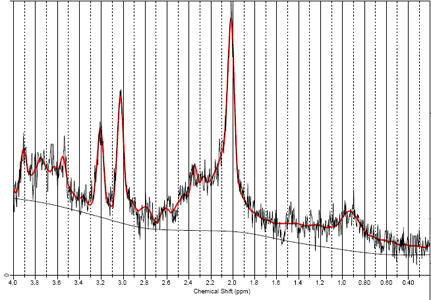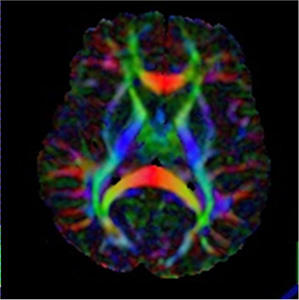Methodology
We are using a range of different methods in our research. Here you can find information about the different methodologies and techniques.
Main content
Functional magnetic resonance imaging (fMRI)
fMRI is a non-invasive technique to study neuronal activation, based on the difference in magnetic properties of oxygenated versus de-oxygenated blood supply to the brain. fMRI is thus an indirect measure of neuronal activity by measuring regional changes in blood supply with the assumption of a positive relationship between neuronal activity and brain metabolism. The contrast in signal intensity between oxygenated and de-oxygenated blood is labelled the Blood-Oxygenation-Level-Dependent (BOLD) contrast.
fMRI brain activation studies were first reported in 1991-1992 (Bellevieau et al. Science, 1991; Bandettini et al., Magn Res Med, 1992) using simple sensory tasks, and has ever since grown in popularity and importance for the understanding of the neuronal basis for cognitive and affective behaviour.
Recent years have also seen the application of fMRI for clinical purposes, mainly in psychiatry, neurology and neurosurgery, but also in radiology. An fMRI investigation requires elaborate post-acquisition processing of the images, where the end product typically is color-coded regions added to an anatomical template of the brain.
Simultaneous EEG-fMRI recordings
Simultaneous EEG-fMRI recordings require the presence of MRI compatible EEG amplifiers and electrodes. EEG-fMRI allows for simultaneous acquisition of electrophysiology (EEG) and hemodynamic (fMRI) information. EEG-fMRI thus provides high spatial and temporal resolution with regard to anatomical localization and on-line signal registration. Because of the large artifacts generated in the EEG recording from the switching on-off of the MRI gradients, particular care has to be taken for artefact removal in the recordings. EEG-fMRI data are often analyzed using an independent component analysis (ICA) approach, which allows for single trial analysis of correlations between e.g. ERP and BOLD amplitudes.
Voxel based morphometry (VBM)
Voxel based morphometry (VBM) is typically used for whole brain comparisons of grey or white matter density or concentration between groups of subjects. VBM is therefore a measure of structural or anatomical differences between e.g. a clinical and a healthy control group. VBM allows for the analysis of tissue concentration on a voxel-by-voxel basis. In this respect VBM differs from other measures of morphometry that e.g. use a region-of-interest (ROI) approach.
VBM data are normalized and mapped to a brain template which reduces the impact of individual differences in brain anatomy.
Diffusion tensor imaging (DTI)
Diffusion tensor imaging (DTI) is a measure of water diffusion in brain tissue and will provide information of white matter structure in the brain on a voxel-by-voxel basis. DTI scans derive neural tract directional information using multidimensional vector algorithms typically based on three or more gradient directions, which is the minimum information in order to compute the diffusion tensor. From the diffusion tensor, diffusion anisotropy measures such as the fractional anisotropy (FA) can then be computed.
The result is visualized as color-coded neuronal tracts where the x-, y- and z- directions typically are coded in red, green and blue, respectively (picture to the right). Recent advances in DTI measurements also allow the researcher to visualize the pathway of a bundle through brain tissue, called DTI tractography. DTI has revealed structural abnormalities related to white matter tracts in a range of psychiatric and neurological disorders and is increasingly used in clinical practice.
Magnetic Resonance Spectroscopy (MRS)
Magnetic Resonance Spectroscopy (MRS) is a non-invasive technique that provides information about brain metabolism through tissue characterization on a biochemical level. MRS information is most commonly based the hydrogen proton nucleus, and can be acquired either in a single- or multivoxel way.
MRS allows for quantification of brain tissue metabolites, such as NAA, Lactate, Alanine, Glutamate/Glutamine, GABA, and others. MRS spectra are dependent on the MR scanner field strength with higher field strengths allowing for improved signal quantification. MRS can be used to identify brain abnormality in both neurological and psychiatric disorders.
Transcranial magnetic stimulation (TMS)
Transcranial magnetic stimulation (TMS) is a method to excite neurons in the brain from the outside of the scalp. TMS uses weak electric currents that are induced in the tissue by rapidly changing magnetic fields, known as electromagnetic induction. The induced TMS pulse thus interferes with neuronal signalling, causing a temporary neuronal inhibition.
TMS allows for localization of cognitive, motor and sensory functions and has an important role in validating e.g. functional imaging methods, like fMRI. TMS has been used as treatment for depression and for auditory hallucinations in schizophrenia. Modern TMS laboratories use MRI-guided neuronavigation techniques to identify anatomical landmarks where to apply the electromagnetic induction coil on the scalp. More information you can find on the website of the FLASH-group.





